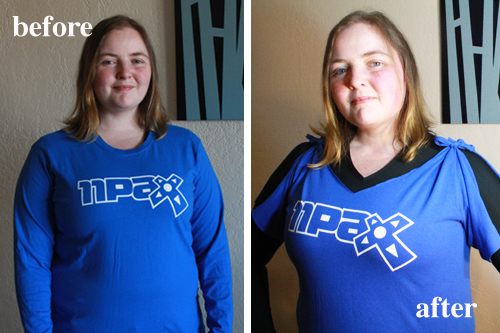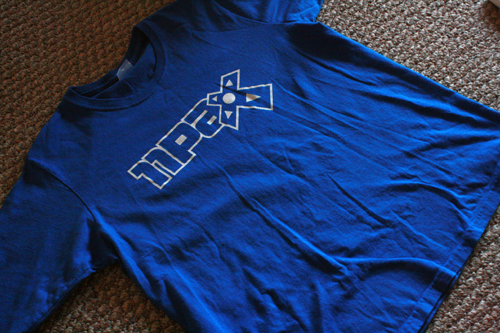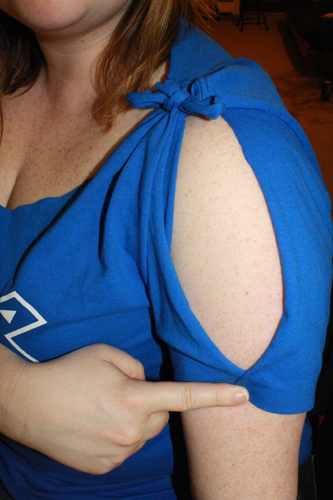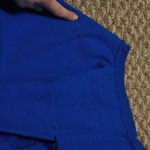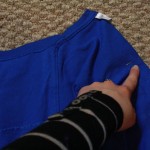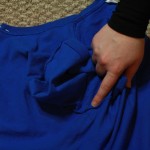My friend Angela recently asked me to help her mod a long sleeve t-shirt. Angela is a PAX Enforcer, and thus has a “uniform” to wear during the twice-annual, three day convention. That uniform is a long-sleeved t-shirt, like the one seen above (which is last year’s iteration). It varies in colour and brand, but the general shirt is always the same.
Enforcers spend a lot of time running around at PAX, working very hard and getting pretty sweaty. Regular PAX attendees, think about how much you sweat at PAX, and then multiply that by… a lot. And as for you Enforcers reading this, well I’m preaching to the choir, aren’t I?
Happily for those who enjoy modding, and for those who want to get a little more airflow than a long-sleeved t-shirt allows, Enforcers are allowed to mess with their shirts, so long as the text on the back and front of the shirt is unaltered and still in its place, and is clearly visible.
Angela wanted to alter the shirt to make it more flattering, and to make it cooler and more comfortable to wear. (Did I mention how much sweating Enforcers do?) In her words:
“Most of my Comfortable tops are open neck lines, so wearing a tshirt that feels constrictive for three days in a row is a little difficult. My goal for the mod was to open up the sleeves and neck line so that the shirt would not only be more flattering but more comfortable.”
Modding can be a scary business, though. As Angela said, “I was so resistent to hacking it, because what if I screwed it up? You only get one shirt.” Which is exactly why we tried out the mod ahead of time on an old PAX shirt (not the end of the world if we messed it up – sad, but not problematic)
Because Enforcers get their shirts the day before PAX starts, there’s not a ton of time to be modding them. And since many Enforcers have travelled from other locations to be at PAX, even those with sewing know-how likely don’t have acess to a sewing machine, whether or not they have the time to get finicky and detailed with shirt modding. So this is what we came up with as a shirt mod that Angela could do without having to sew, and using tools and supplies that she could either take with her in her luggage or (in the case of the iron and ironing board) find in a hotel room.
And how did Angela feel about the results?
“Tally and I were so successful in this mod, I now have a treasured shirt from PAX that I am comfortable wearing out and about. I think it also looks great with my under armour shirt, which helps me stay cool and keep from sweating onto my only shirt for the weekend!”
——————————————
What you’ll need
materials:
- a shirt to mod
- hem tape – This is a fusible adhesive you can use to hem clothes without sewing them. It’s essentially a glue/tape combo meant for fabric. You can get it at fabric stores and many craft stores. Hobby Lobby and JoAnne Fabric & Craft Stores both carry it, and Michaels even has one that apparently does not require ironing.)
- good scissors (proper fabric scissors are obviously ideal here)
- ruler or other straight edge (like the side of a book)
- pencil OR chalk or a white crayon (if your shirt is black or very dark colour)
- iron and ironing board
- straight pins
- measuring tape (Or you can just use a piece of string or ribbon or something. There’s not super duper precise measuring required for this mod.)
——————————————
Modding the sleeves
1) This tutorial assumes that you have a long sleeved shirt, since all Enforcer shirts are long sleeved. But if you’re doing this with a short sleeved shirt, just skip ahead to step 4, and also ignore all the stuff about using the hem tape, since your sleeves will already have a proper hem on them.
Put your shirt on inside out and figure out where you want the sleeves to come to. Make a little pencil mark at that place on one sleeve. We did not do this, we just sort of eyeballed it, which is why the shirt is right side out and devoid of pencil marks on the sleeves in the next couple photos. However, this is one of those “do as we say, not as we do” scenarios. We should have done this step, but didn’t think of it at the time. Hindsight. Benefit from ours.
Also, turn on the iron so it can heat up while you’re doing the next couple steps.
2) Take the shirt off and lay it out flat (still inside out). Then fold it very exactly in half, matching up the body of the shirt and the sleeves of the shirt as precisely as possible. Make sure the sleeve with the pencil mark on it is on top, so you can see the mark. You can us a couple pins to hold everything in place, if you wish.
3) Look for your pencil mark on the sleeve, and cut straight across the sleeves (cutting through all 4 layers of fabric of the stacked shirt sleeves) about 1 & 1/2 inches below that pencil mark.*
*Actually, to be super precise, look at your hem tape. How wide across is it? Double that width, and that’s how far down from the pencil mark you need to cut. So if your hem tape is 1/2 inch wide, cut across the sleeves 1 inch below where you made the pencil mark.

4) Keeping the shirt inside out, lay one now-shortened sleeve of the shirt out flat, with its top side facing up.
5) Use ruler or straight edge and a pencil (or chalk, or white crayon) to draw a straight line from the place where the sleeve meets the shirt’s shoulder seam, to the bottom middle of the sleeve.
6) Cut along the line you just drew (make sure you’re only cutting through one layer of fabric!), all the way to the top of the sleeve where the shoulder seam begins.
It’s a good idea to try the shirt on again at this point, to make sure everything is looking about right. The sleeves should be about 1 inch to 1 1/2 inches longer than you want them to be in the end. You can actually stop here, if you cut the sleeves as short as you want them in the first place, and just don’t do the thing with the hem tape that’s covered in the next few steps. However, hems look nicer and keep better than raw edges, so it’s nice to do them when you can. Also, in this case, the hem will add a little extra weight to the bottom of the sleeve, helping it to hang better.
7) Lay the cut sleeve out so that the bottom of the sleeve is a straight line, with the inside of the sleeve facing up at you. Cut a piece of hem tape that’s the same length as the full bottom line of the sleeve.
8) Lay the piece of hem tape down along the bottom edge of the sleeve. Fold the bottom of the sleeve over, so that the hem tape is hidden from view.
9) Run the iron over the folded-over fabric, fusing the fabric and hem tape together, and effectively gluing the fabric down. Follow the exact instructions on the package of whatever hem tape you bought as to what the iron should be set at, and how long to hold it down on the fabric, etc. One nice thing about t-shirt fabric is it’s pretty hard to really ruin it with an iron, unless you leave the iron sitting on top of it for minutes at a time. The colour of the shirt may change slightly where the iron has touched it, but that’s a temporary effect and will fade away in a few seconds to a minute.
10) Repeat steps 4-9 with the other sleeve.
11) [Optional] For a slightly different look, or to leave the sleeves breezy but not quite so open, bring the sleeves back together at the bottom of the cut and sew them together, maybe with a little button or bow decoration on top.
Cutting a new neckline
What I’m about to describe is a handy technique for cutting a new neckline in a t-shirt, no matter how big or what exact shape you want the new neckline to be. This is how to cut a nice, even, symmetrical neckline, without any issues of it being uneven or bigger or differently shaped on one side than on the other.
1) Make sure the shirt is inside out. Now, normally you lay a shirt down flat so that the back and front of the shirt form a double layer of cloth, lying there, and the sleeves point out from either side. But this time, you’re going to lay your shirt out so that it folds down the middle of the shirt’s front and the middle of the shirt’s back. The sleeves should be in the middle of the shirt, one facing up, and one hidden underneath the shirt.
3) Pin both sides of the shirt together at the shoulder, in two or three places along the shirt’s collar, under the arm and in two or three places along the fold on the shirt’s front and the fold on the shirt’s back.
4) Use a pencil or chalk or a white crayon to draw a new neckline on the front, going from the middle fold on the front of the shirt to the shoulder. Starting at the same place on the shoulder, draw another new line on the back side of the shirt.
Important Note: It does not take much to widen the neckline significantly. Even if you want a very open neck, draw the line much closer in to the original t-shirt collar than you think it should be – you’ll probably be surprised at how big the opening turns out. And if it’s not big enough, you can always go back and cut more off. But you can’t add fabric back on if you cut the opening too big.
8) Cut carefully and neatly along the lines you drew.
9) Unpin the shirt, turn it right side out and try it on. If the opening is not big enough, or not the shape you were hoping for, refold, repin and cut a bit more to get the neckline the way you want it.
11) Optional: Cut a strip of fabric off of the sleeve leftovers – the bottoms of the sleeves that got removed. Make the strip as long as possible, and about 1 1/2 to 2 inches wide. Once it’s cut, pull on it from either end. The strip of fabric will curl up in to a rounded, rope-like piece. Cut a second strip and do the same thing with it. You can use these to make little ties on either shoulder, as in the picture below.
A couple other thoughts: Because of the no-sew consideration, we haven’t done anything to finish the edges of the new neckline here, and as mentioned before, t-shirt fabric doesn’t really fray much, especially not in the short term, so you should be ok running around with a raw-edged neckline for a few days. However, if you want to do something to finish it up a little, you could always use your hem tape to fuse some ribbon along the edge of the neckline, either on the inside (just for stability) or on the outside (stability and added visual detail.)
You can also certainly hand-stitch a hem (or ribbon) onto either the sleeves or the neckline, but this requires more time and probably some practice with hand sewing to make it look tidy, which is why we haven’t gone that route here. It’s totally doable, though.
You could also go over any raw edges where you’re worried about fraying with a bit of clear (or coloured) nail polish, or with fray check (available at fabric and some craft stores). Just be careful with the nail polish option – it’s tricky to get it to go on evenly and not clump and look totally tacky, and if you’re wearing your shirt without any body armour underneath, you might find that the dried nail polish is a little scratchy.
12) Enjoy some fresh air getting in under your shirt during all the crazy running around at PAX!

